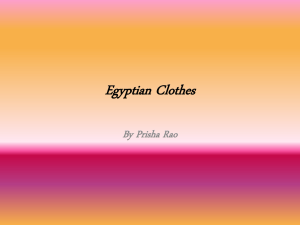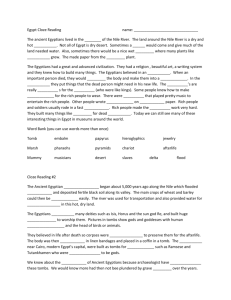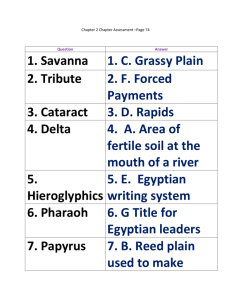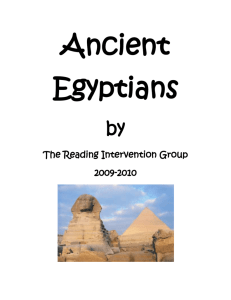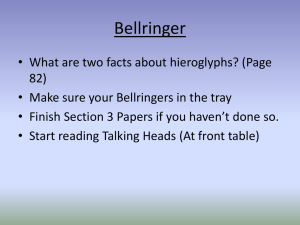EgyptianDailyLife
advertisement
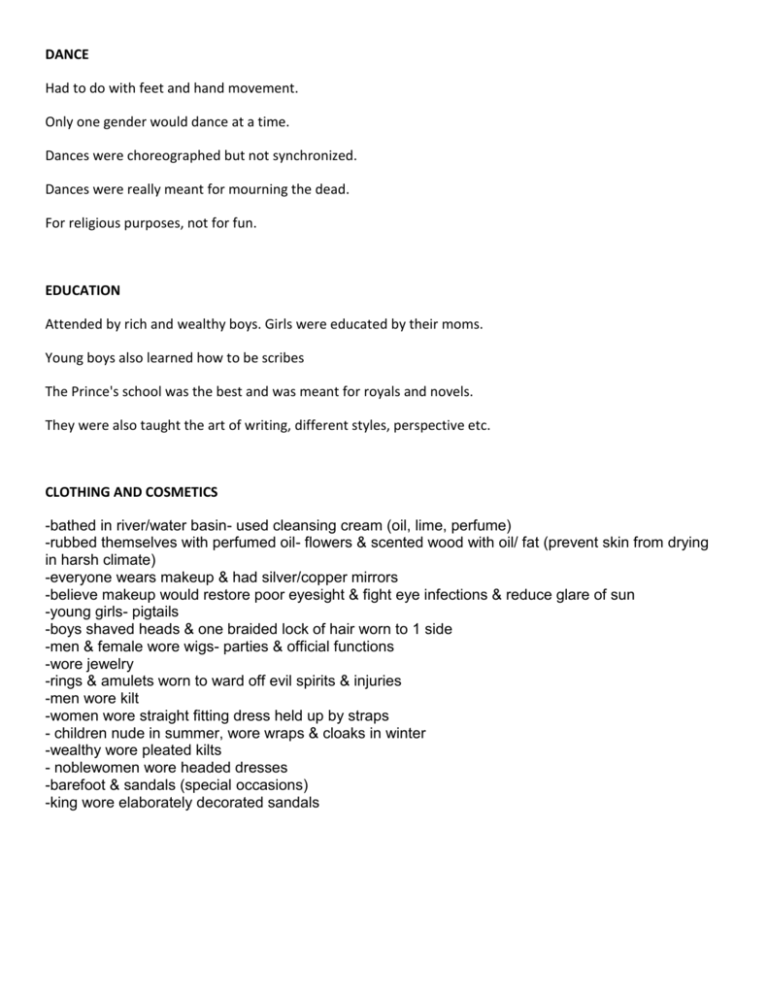
DANCE Had to do with feet and hand movement. Only one gender would dance at a time. Dances were choreographed but not synchronized. Dances were really meant for mourning the dead. For religious purposes, not for fun. EDUCATION Attended by rich and wealthy boys. Girls were educated by their moms. Young boys also learned how to be scribes The Prince's school was the best and was meant for royals and novels. They were also taught the art of writing, different styles, perspective etc. CLOTHING AND COSMETICS -bathed in river/water basin- used cleansing cream (oil, lime, perfume) -rubbed themselves with perfumed oil- flowers & scented wood with oil/ fat (prevent skin from drying in harsh climate) -everyone wears makeup & had silver/copper mirrors -believe makeup would restore poor eyesight & fight eye infections & reduce glare of sun -young girls- pigtails -boys shaved heads & one braided lock of hair worn to 1 side -men & female wore wigs- parties & official functions -wore jewelry -rings & amulets worn to ward off evil spirits & injuries -men wore kilt -women wore straight fitting dress held up by straps - children nude in summer, wore wraps & cloaks in winter -wealthy wore pleated kilts - noblewomen wore headed dresses -barefoot & sandals (special occasions) -king wore elaborately decorated sandals Homes in Ancient Egypt Made out of mud bricks Roof is made of wooden beams covered in clay and pirates In the centre of the house was a “living room” or a central room Most villa’s contained a toilet/ bathroom Staircase leading to the roof Spent time on the roof Wet mats on the floor in the house to cool the house Interior walls plastered with mud and painted with colourful scene The house reflected your social status In less densely populated areas, the rich build large villas Each estate contained of a main house with gardens as well as separate buildings used as kitchens, stables, servants’ quarters, and all of it was surrounded by a mud brick wall Wooden stools, chairs, beds and chests Light was shone from candles and lamps Town villas were smaller than those in the country and were occupied by an extended family The surrounded mud walls in the town would be taller and the courtyard would be smaller Living conditions for the farmers would be different. Lived in humble dwellings consisting of one or two rooms. Similar layouts as the villas but smaller in size Still built of mud bricks and palm tree trunks and surrounded by walls Vents on the roof provided cool air from the north and drains running down got rid of any water on the roof In the cities, people lived in smaller homes that were closer together with no gardens A door from the street lead to the workroom in the house The door from the workroom would lead to the rest of the house Middle class houses would be small and narrow as well but might have 2nd or 3rd floors Games and Leisure in Ancient Egypt. Hunting: - Egyptians went outside to hunt in the marshes to search and hunt for water fowl. - Pharaoh sahure enjoyed hunting animals like deer, gazelles and antelopes - Noble men captured wild animals and peasants chased after gazelle, oxen, hares and ostriches. Fishing as a past time - as Egyptians lived by the river Nile, fishing was a popular activity and fish were a major food source. Music as a pastime ancient Egyptians loved music. Leisure time in the garden Most people have gardens next to their houses, wealthier people had ponds. River games Egyptians often had an old fashioned drag race with boats made of reed in the river nile. Swimming. They swam.. most likely in the river nile Parties Dubstep and house were not around, but they still enjoyed partying. The more wealthy people usually held them. Family -Marriages in Egypt were mostly arranged by family members, but some were based off of love but still needed the parents approval -Got married in their 20's or their teens -No legal process to get married, but there was a celebration -Marriage between siblings in Egypt weren't as common as first thought but still happened -Couples that had babies gained prestige -Women handled the house work and men handled physical labour. Food - fish incorporated in w number of dishes - pork and beef -bread and beer - wheat in abundance - bread, cakes - recipes made from wheat often sweetened with honey - preparation for bread is labour intensive ,had to be ground by hand then baked in archaic ovens. - vegetables were also common (Peas, beans, onions,garlic , leeks, cabbages, turnips ) -agriculture was important due to the fertile land around the Nile - fig and dates We're extremely popular Festivals -religious or political festivals allowed both rich and poor for a day or two sometimes longer -festival calendars contained explicit references to offerings that that were required by dirties associated with these events -most knowledge about such events is found at medinet habu -kept record to exact number of bread loaves ,cakes ,beer ,containers, meat , fowl , incense cultiv charcoal and such


